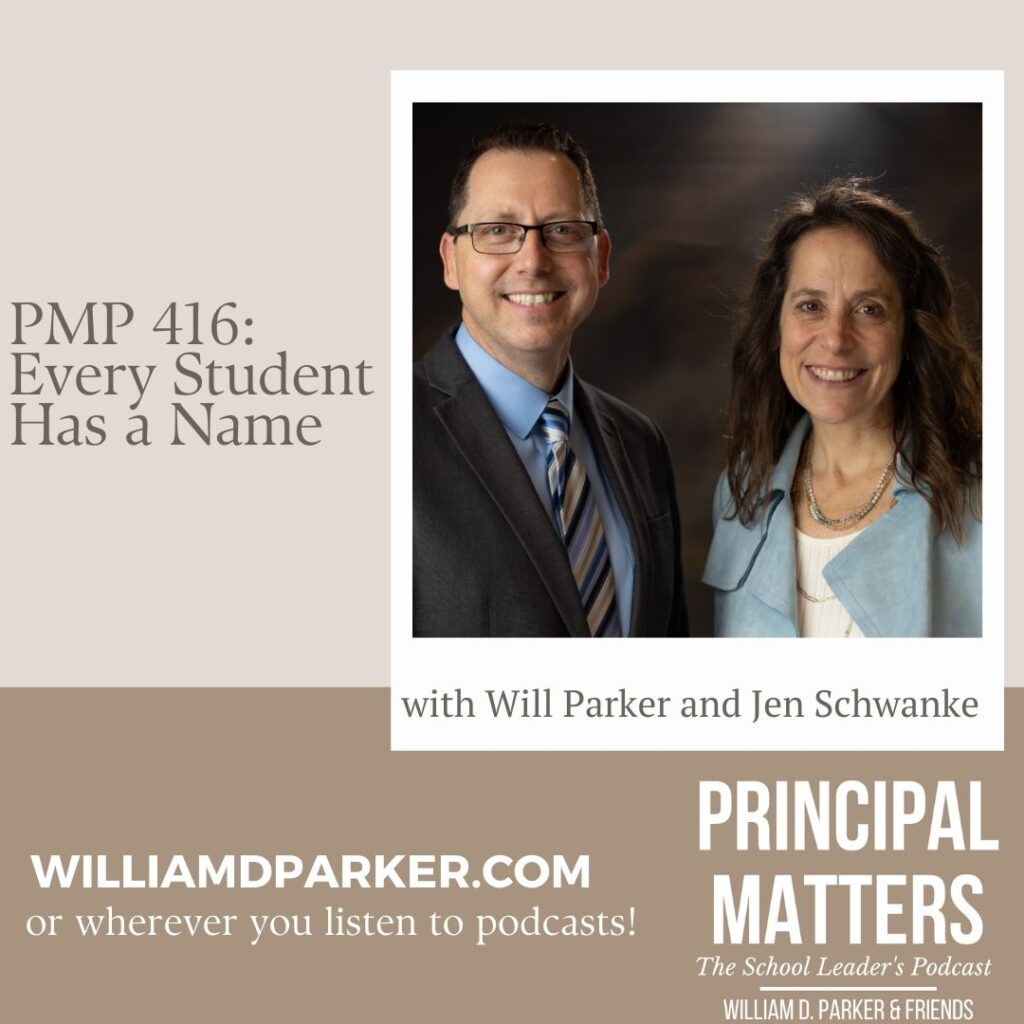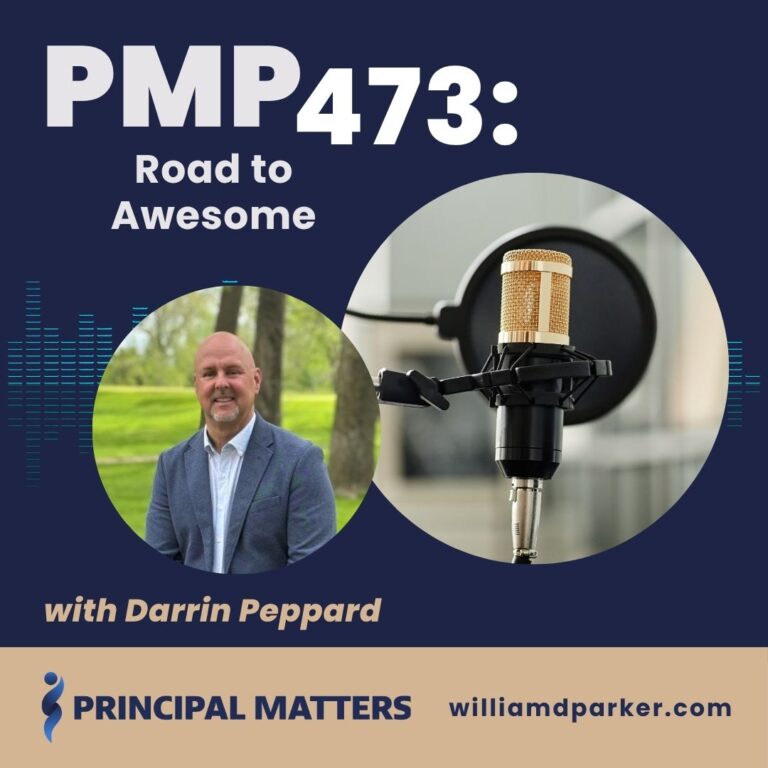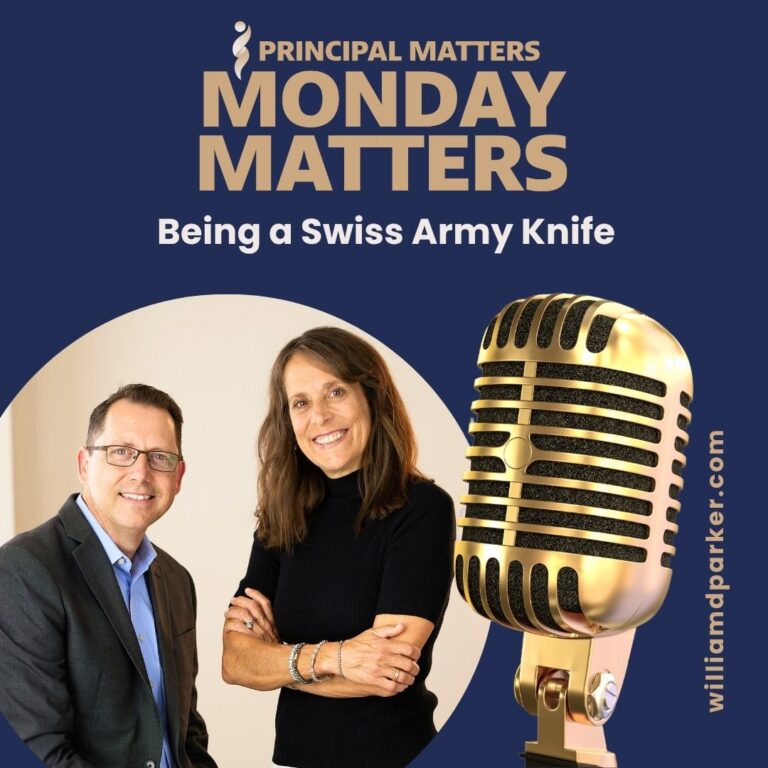Podcast: Play in new window | Download
A quick note to listeners:
Before this week’s interview, Jen Schwanke and Will Parker answered a listener question in a 5-minute response.
The question is: What’s the best way to find a ‘balanced’ leadership team when interviewing?
It’s hard sometimes to go ‘deep’ and really see who people are in a formal interview.
Will mentions a resource from Jimmy Casas. Go here for a summary of his Hiring for Excellence tips and other links to Jimmy’s great resources.
Listen in for our response and thank you for doing what matters!
Mark Your Calendars! Virtual Series in Partnership with SAANYS
Jen and Will also talk about a year-long virtual series they and other Principal Matters Associates are offering in partnership with the School Administrators Association of New York State, Managing Culture, Conflict and Conversations. This offering begins October 16, 2024, and is followed by ongoing learning once a month through the spring semester. You can find out more via this flyer: https://qrs.ly/sgg4bzu. Or register here.
From Will:

Every Student Has a Name
by William D. Parker
This week’s episode is a conversation I had with Jen Schwanke based on a post I wrote while traveling to an education conference. I’m including the post below, but the conversation in today’s episode includes Jen’s feedback as we expanded the conversation to include the following:
- How accountability standards often de-motivate schools from their essential mission.
- How collective efficacy and the belief that all children can learn proves to be one of the most influential forces in positive school outcomes.
- How understanding the dynamics of individual significance and collective results leads to better outcomes for everyone.
I hope you enjoy the conversation and the post below. Thank you for learning together and for doing what matters! ~ Will Parker
This past semester, I flew over a sea of humanity on my way to an education conference. It was sunrise above Chicago, and a rose-colored sky was awakening above the dark expanse of Lake Michigan. As our plane banked and turned toward the airport landing, the panorama of city life was already crawling with the thousands of twinkling yellows and reds of headlights and taillights.
Every highway was lined and several were already stalled with traffic flowing into the city. It was 7:00 a.m. CT, and surrounding every street were the millions of lights marking humanity — homes, businesses, and schools. Although my vantage point only allowed me to see headlights, porch lights, or street lights, I realized each one marked a spot where someone was sleeping, waking, working, or traveling.
In one way of seeing the world, this is just a panorama of lights, but from another vantage point, these lights mark something much more significant. For me, it’s a bit overwhelming. If every light marks a point of humanity, then how do you reconcile yourself to the unique, individual gifts and talents of each person marked by those lights?
In contrast, I recently watched the documentary, My Name is Salt, by Farida Pacha, about families who work eight months each year in the desert of Little Rann of Kutch, a 5000 sq km of saline desert in the Gujarat State in India. Filmed in 2013, the story with no script follows the lives of one family who works eight months each year in this desert. Each year, 40,000 people return to this area from villages to flood fields of mud and uncover salt. The painstaking work requires digging border trenches by hand, using a diesel-powered water pump to flood the fields with saline water. Families pay to have their drinking water trucked in. They live in primitive huts on dirt floors, and their children attend school, funded by an NGO.
Their setting is a different sea of humanity — groups of families who have been returning to this area for generations to harvest and sell salt. When you follow them through meal times in tents around small fires, wading in water to rack salt, walking long distances to attend a one-tent schoolhouse, you are struck by their perseverance, confidence, and courage to live in such harsh conditions, raise their children, and return each year for the same cycle of work.
Back in the more developed communities or neighborhoods where you and I live, ours is also a unique sea of humanity. Whether you live in a rural farm setting, a sprawling suburban neighborhood, or an urban cityscape, each place is marked by its own cultural norms, sets of values, conflicts, and triumphs.
Thoughts on Accountability
For a school, each student represents a whole set of unique points of humanity. A student represents a family, parents, grandparents, brothers and sisters. Each student has a unique background that he or she brings to school each day. We don’t always know their stories, but when we uncover the gifts, talents, and perspectives each student brings to learning, we are often surprised but what each one has to offer to the whole. We are also surprised by how much each student has in common with others.
When educators are asked how their schools are performing, we go to data: attendance records, disciplinary logs, achievement data — but these points of data are ultimately numbers that point back to the humanity of our students. Each data point represents a face of a child.
Data is a small measurement of the experience or life of a human being in our care for a set number of days in his or her life. When we ask the questions: “What are they learning?”, and “How do we know they are learning it?”, we need more than numbers to tell us the answers to those questions.
This past year, I led several leadership groups and individuals through a book study on Patrick Lencioni’s The Five Dysfunctions of a Team. The book is written as a fable of a tech company struggling to meet its targets, and a new CEO, Kathryn, who has been assigned to determine solutions for a struggling leadership team. Kathryn, a former 7th grade teacher who transitioned her career into industry executive, shares five dysfunctions she sees in underperforming teams:
- Absence of trust.
- Fear of conflict.
- Lack of commitment.
- Avoidance of accountability.
- Inattention to results.
The flip side of this equation is the components that make up strong teams:
- They trust one another.
- They engage in unfiltered conflict around ideas.
- They commit to decisions and plans of action.
- They hold one another accountable for delivering against those plans.
- They focus on the achievement of the collective result (The Five Dysfunctions of a Team, by Patrick Lencioni, pages 189-190).
Notice the final two categories in each list, numbers 4 and 5. In the book, the author attributes “avoidance of accountability” to low standards. In the category of “inattention to results,” he connects this behavior to the obsession with status and ego as opposed to shared outcomes.
Whenever I’m working with educators, tension normally arises when talking about accountability with questions like this:
How do I complete the work assigned to me individually while at the same time, adequately supervising the complexities of the work of others?
For teachers, the question might be phrased like this: How do I maintain my autonomy as an instructor while I’m being asked to share data and examine outcomes with other teachers?
These questions are normal responses in any work environment. We want to be excellent at our work. At the same time, no one works in a vacuum. We are all dependent on others to complete the important tasks of any job, task, or project.
These same tensions exist in our students. They are justifiably concerned about their grades and outcomes. At the same time, they recognize school is more than just their accomplishments – they are part of a community of other learners too.
So what difference does looking at our shared humanity make for school leaders and their responsibility to hold others accountable?
I think accountability, like most areas in leadership, has two sides to the same coin we must examine. On the one side, we need to recognize the unique individuals who make up every setting in education: students, teachers, administrators, and parents are people. They have faces and names. They must be treated with the respect and dignity that every human being deserves. Each one marks an important place in the world that no one else marks.
On the other side of the coin, we make up a collective community of people. Together we share learning spaces, eat together, learn together, follow the same calendars, complete learning standards, compete in extracurricular activities, reteach concepts, and master achievement.
At the end of the day, these two truths work in tandem together:
1) Each person is unique and important;
2) The cohesiveness and outcomes of our community as a whole are as important as the individuals.
Let’s consider an example of student discipline from the perspective of a school administrator. Whenever you are correcting the behavior of a student whose conduct is out-of-line, you are accomplishing two goals at once. First, you are wanting that student to live up to his or her best potential. Also, you are wanting to maintain behavior that helps everyone live together in a way where mutual trust and safety are maintained. Both truths are important.
If you forget about the individual, you become an educator who treats students like cogs in wheels, and they don’t feel heard or valued. At the same time, if you forget about the community, you may fail to consider appropriate consequences, apologies, or reconciliation that need to happen when trust is broken with another student or a teacher, and reconciliation or rebuilding of trust is essential to the whole.
This is not an easy task, but it may be a simpler one if you keep in mind both perspectives as a healthy and necessary tension as you pursue a stronger balance in accountability for individuals and school-wide accountability. What difference would it make if you reflected on these competing but important priorities when for teacher observations, professional learning community, or parent feedback?
Today as you step into the sea of humanity you call a school, give yourself permission to recognize the light each face brings. Also, give yourself permission to take the bird’s eye view of your school as a combination of people, experiences, systems, and outcomes.
For school leaders, the decisions you make today when holding others accountable must keep both those realities in mind at the same time.
Now It’s Your Turn:
Reflect on these questions as you interact with important decisions today:
- What is best for this student?
- What is the impact my decisions will have on the whole community?
- How can the interests of the individual and community go hand in hand as you serve those around you today?
Thank you again for doing what matters!




